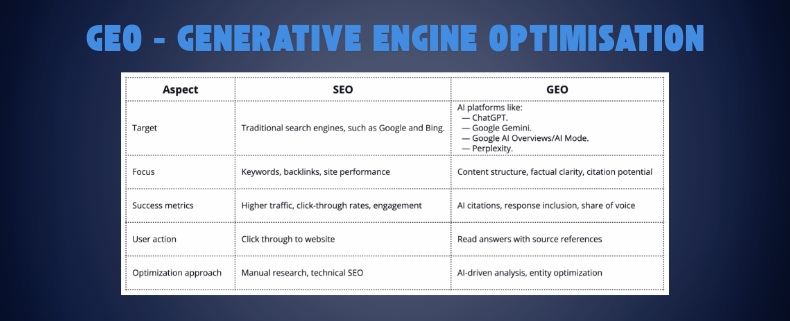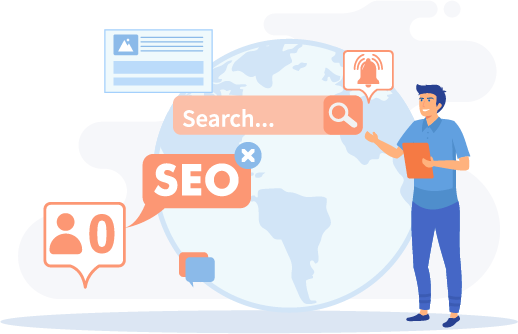GEO SEO Sydney | Generative Engine Optimisation
I’ve spent the last 25 years helping small business owners cut through the online noise.
The very first site I built was IndieFilmWeb.com—Australia’s first-ever streaming film and music website. I launched it on August 14, 2000, four years before YouTube even existed!
Sponsored exclusively by Apple, IFW was a pioneer, and let Aussies stream films straight to their desktops via the internet, which was the FIRST TIME in Australian history that this was ever possible.

Since then of course a lot has changed out there in the world wide web. And over the years I’ve witnessed (and adapted to) every algorithmic shake-up Google has thrown the SEO community. And trust me, there has been a lot of “SEO is dead” hot takes over the years because of them! But (spoiler alert) it never is. SEO just evolves. And as Sydney small business owners, so must you.
Now, in 2025, with AI baked into search engines, the ground under our feet is shifting again.
Enter: Generative Engine Optimisation (GEO).
So, if you’re a Sydney business owner who wants to know how to stay visible in Google’s AI-driven world, then trust me when I say that you’re going to want to read this article in full, because the changes are going to spin your eyeballs back in your head like slot-machines!
What is GEO SEO?
GEO SEO is the process of making your content visible and valuable to generative AI systems. These systems now power features like Google’s AI Overviews and Microsoft’s Copilot, and they no longer serve up long lists of links. Instead, they generate direct answers from trusted online sources.
Where traditional SEO aims to get your content ranking on Google’s first page, GEO SEO shifts the focus to being selected by AI engines as the most useful response to a query.
This distinction is crucial—AI-generated responses don’t simply list links. They summarise, quote, and contextualise information directly from web pages that demonstrate clarity, authority, and relevance.
This means that to optimise for GEO, your site content must not only be accurate and useful but also structured in a way that makes it easy for AI to digest and repurpose. Think of your content not just as a web page, but as a reliable data source for AI assistants.


Why GEO SEO Matters to Sydney Small Business Owners Like You
Sydney is a competitive market. I’m sure I don’t have to tell you that! Whether you’re a plumber in Parramatta, a mortgage broker in Manly, or a physio in the CBD, you’re not just competing with other local businesses—you’re also up against national brands with bigger budgets who also happen to be targeting Sydney.
This is where GEO SEO levels the playing field. Unlike paid ads or high-authority backlink profiles, Generative Engine Optimisation gives smaller businesses the opportunity to shine based on the quality of their content. AI engines don’t care how much you spent on Google Ads. They care about how well your content answers a user’s question.
GEO gives small businesses the power to:
- Appear in voice search and smart assistant queries.
- Be quoted in AI-generated answer boxes.
- Surface in visual search tools and conversational interfaces.
All of which are becoming more common with each passing month. And if your business isn’t GEO-optimised, your company is going to lose a lot of leads to the companies that are.
What types of Content Perform Well in GEO?
GEO SEO thrives on clarity and structure. Content that is written in a clean, conversational format performs best. This includes:
- FAQs written in a natural tone.
- “How to” guides that outline processes step-by-step.
- Service pages that clearly list inclusions, prices, and processes.
- Blog posts that directly answer common client queries.
To rank in generative engines, each page should serve a clear purpose. Rambling, bloated content is no longer effective. Instead, tight, well-structured content that provides answers up front is rewarded.


How Do I Know if My content is GEO-Ready?
Ask yourself:
- Can someone find the information they need in under 10 seconds?
- Are your answers front-loaded (i.e. the answer appears in the first two lines)?
- Do you use structured formatting like headers, bullet points, and tables?
- Have you removed filler language and repetition?
If the answer to these questions is ‘yes’, you’re on the right track.
How To Optimise Your Sydney Business Website for GEO
This next bit is crucial and completely changes how you should approach your any new content you upload to your company website.


Write for People—Format for AI
Human-friendly language remains essential, but formatting for AI is equally important. Use simple sentence structures. Keep it clear. Avoid complex industry jargon. Think like your customers do. If someone asked you a question in person, how would you answer it? That’s how your content should sound.
Avoid fluff and repetition. Generative engines are scanning for answers, not long-winded explanations. Provide the solution up front, then support it with detail below.
Use Location-Based Keywords
Search engines need context, especially when providing geographically relevant responses. GEO content must include:
- Suburb-specific references (e.g. “Blocked drain repairs in Balmain”)
- Regional modifiers (e.g. “Sydney-based ecommerce SEO consultant”)
- Postcode identifiers (if applicable for service area pages)
Don’t just drop Sydney in your footer and call it done. Bake locality into your headings, body copy, and image alt text.


Build Pages Around Questions
GEO engines love questions—and even more, they love clear answers.
Try building dedicated content sections or blog posts around:
- What’s the average cost of [service] in Sydney?
- How long does [service] take in [suburb]?
- Who is the best [service provider] in [location]?
- Do I need council approval for [service] in NSW?
By answering these, you not only win favour with generative engines—you provide true value to your audience.
Advanced GEO Tips from SEO North Sydney
Okay, so now you’re getting your head around GEO SEO, let’s dig a little deeper into the topic. Because like most things related to digital marketing, the devil is most certainly, in the details.


Use Natural Language Q&A Blocks
Rather than burying your answers in dense paragraphs, format them as clear questions and direct answers. This mirrors how voice search and AI tools interpret intent.
Update Content Regularly
AI algorithms place value on freshness. A blog post written five years ago might still be technically correct—but if it hasn’t been updated recently, it likely won’t be trusted as a primary source.
Review and revise core content every quarter. Even small changes signal to AI that your site is current.


Use Original Images
This is especially important for industries like hospitality, fitness, retail, and trades. Uploading real photos—tagged with descriptive filenames and alt text—helps AI associate your business with authenticity. Avoid stock imagery where possible.
Build Local Links
Backlinks still matter, even in GEO. And how! Google built an empire on the Page Rank algorithm back in the day, and while how Google values links has changed, their importance certainly hasn’t. And Google loves ranking local businesses locally. So, help it realise that the local business they need to rank is yours.
Prioritise:
- Getting listed in Sydney-specific business directories.
- Participating in local events and asking for mention links.
- Submitting case studies or testimonials to locally based industry bodies.
Each of these helps reinforce your site’s relevance to local AI-driven searches.


Balancing GEO with Traditional SEO—the Way Forward
GEO does not make traditional SEO redundant. Far from it. It enhances it.
Keywords, mobile speed, backlinks, on-page and off-page SEO, technical SEO and crawlability still underpin your website’s visibility in Google, Bing, etc. But now, layering GEO on top of those basics gives you a hybrid approach—one that serves both human users and AI systems.
To balance both effectively:
- Use long-tail and short-tail keywords naturally.
- Ensure pages are mobile-first.
- Include local FAQs on key landing pages.
- Structure service pages to answer specific, high-intent questions.
- Internally link related blog content to signal topic authority.
Think of traditional SEO as both the foundation of your digital marketing HQ and the first 50 storeys. And think of GEO SEO as the upper floor penthouse that gives you the best view.
The Future of GEO–Where to From Here?
As Generative Engine Optimisation (GEO) becomes the next frontier in search visibility, many small business owners are asking the same question: where is this heading? Just when we’d all finally wrapped our heads around Google’s latest algorithm updates, along comes AI-generated search to rewrite the rules. But, to quote the late, great Douglas Adams: “Don’t panic!” Because, if history has taught us anything, it’s this: SEO doesn’t die, it just evolves. And GEO is just the next chapter in the ongoing story of how people find information online.


What Will GEO Look Like in 12–24 Months?
GEO, right now, is still in its infancy. AI-generated summaries on platforms like Google’s Search Generative Experience (SGE), Microsoft Copilot, and even ChatGPT’s browsing tool are essentially prototypes. But fast-forward 12 to 24 months and we can expect:
- Wider adoption across all major search engines – GEO snippets will likely appear in most search results, not just experimental ones.
- Higher trust in AI outputs – As AI gets more accurate, users will increasingly rely on AI summaries rather than clicking through to websites.
- Integrated monetisation – Expect to see sponsored GEO content placements, much like how Google Ads evolved.
- Voice-first interaction – With Siri, Alexa, and Google Assistant improving daily, GEO content will be prioritised in spoken responses.
What does that mean for your business? Your content must evolve from just ranking to being recognised, summarised, and spoken by machines — and that changes how we write, structure, and publish.
Let’s put the neck on the line even further:
- GEO replaces traditional snippets in over 50% of search results.
- Search engines become answer engines — users stop clicking, and trust the blurb.
- GEO becomes part of every SEO strategy — like mobile optimisation and site speed.
- AI assistants become gatekeepers — and they’ll only quote businesses that speak their language (structured, conversational, schema-backed).
- Trust signals go mainstream — user reviews, E-E-A-T signals, and clear authorship become decisive factors.
AI and Human Writers–Collaborators, Not Competitors
One of the biggest misconceptions is that AI will replace writers. That’s unlikely. Why? Because:
- AI mimics, it doesn’t originate. It pulls from what already exists — your content, if it’s good enough.
- Google still prioritises human-written, original content in its ranking systems.
- Readers value tone, personality, and storytelling — something AI still struggles with.
In the future, the winners in GEO will be those who use AI strategically. Think:
Brainstorm with AI, but write with soul.


The Future Is Conversational
AI doesn’t “search” like we do — it chats. Which means the web is shifting toward conversational content. GEO-friendly content will increasingly:
- Mimic the tone and cadence of a Q&A with a real human.
- Use natural language instead of SEO keyword stuffing.
- Answer specific, user-intent-driven questions (e.g., “How can I fix a leaking pipe in Surry Hills?” rather than just “Plumber Sydney”).
Expect the rise of FAQ-rich pages, voice-search optimised blogs, and local guides written in plain language, designed to be quoted directly by AI engines.
Structured Data Will Become Mandatory
Schema markup and structured data are already powerful SEO tools. But in a GEO-dominated future, they’ll be non-negotiable. Here’s why:
- AI needs clearly labelled data to interpret and summarise it accurately.
- Businesses that fail to implement schema will simply be ignored by generative engines.
- Expect new types of schema tailored specifically for AI — think “AI Summary Blocks” or “GEO Snippets.”
At SEO North Sydney, we’re already building this into our clients’ sites — because if you’re not structuring your content for machines, you’re not in the game.


GEO Will Reward Real Businesses—Not Just Big Ones
One of the most exciting things about GEO? It levels the playing field.
- AI doesn’t rank by brand name. It ranks by answer quality, clarity, and trustworthiness.
- A small Sydney plumber with a brilliant “How-to” blog can be quoted above a massive franchise.
- Your business might already have the right content — you just need to structure it correctly.
So, while big brands will throw millions at GEO consultants, smart local businesses (with the right agency backing them) can still dominate.
Effective Strategies for Successfully Combining GEO and SEO
As the digital landscape rapidly evolves, Generative Engine Optimisation (GEO) and traditional Search Engine Optimisation (SEO) are no longer distinct silos—they are two sides of the same coin. To compete in a world where Google is shifting from a Search Engine to an Answer Engine, your digital marketing strategy must bridge the gap between these technologies. That means aligning SEO’s technical foundation with GEO’s content-first, AI-facing framework.


GEO vs Traditional SEO–Key Differences
- Traditional SEO focuses on search engine rankings.
- GEO focuses on content discoverability by AI systems.
- SEO is about keywords, metadata, and backlinks.
- GEO is about content clarity, structure, authority, and machine-readability.
While SEO and GEO work in tandem, they target slightly different endpoints. With GEO, the goal is not just to be found—it’s to be used by AI in answering questions.
5 Essential GEO SEO Strategies
Below are the five essential strategies for integrating GEO and SEO into one cohesive, future-proofed approach.


Unified Content Strategy for Humans, Search Engines, and AI Models
At the heart of both SEO and GEO lies one simple truth: content is king. But in this new era, it’s no longer enough to write content that ranks. You must create content that resonates across platforms—whether it’s indexed by Googlebot, parsed by a GPT-powered AI assistant, or read aloud by a voice search tool.
Here’s how to achieve this:
- Write for multi-platform consumption.
- Focus on value and clarity.
- Embrace E-E-A-T.
- Structure your information well.
A unified content strategy is the linchpin that connects traditional SEO visibility with generative engine credibility.
How to Bridging Search and AI Query Patterns
Traditional SEO has long revolved around keyword targeting. But GEO expands the playing field by introducing natural language, intent-based, and contextual queries.
Your research process should now include:
- Classic keyword volume research.
- Long-tail and conversational search terms.
- Question-based queries.
- Semantic clusters and entity mapping.
Success lies in understanding how users are searching—and ensuring your content matches that evolving behaviour, whether typed, tapped, or spoken.


Technical Excellence That Supports Both SEO and GEO Performance
The best content in the world won’t perform if your technical infrastructure is lacking. From traditional crawlability to machine learning-friendly markup, technical optimisation underpins everything.
Key areas to prioritise include:
- Site speed.
- Mobile optimisation.
- Structured data/schema markup.
- Natural language flow.
Technical SEO isn’t just about appeasing bots—it’s about empowering your content to be discovered, understood, and reused across modern AI-driven experiences.
Continuous Learning and Adaptive Optimisation
Digital marketing is a moving target. What worked yesterday may underperform tomorrow—especially with Google rolling out SGE (Search Generative Experience) and OpenAI experimenting with web-integrated browsing. Staying still is no longer an option.
To stay ahead, your team must:
- Monitor updates.
- Regularly audit your site.
- Experiment with emerging tools and platforms.
- Attend webinars, read thought leadership blogs.
Adaptation isn’t a once-a-year exercise—it’s a mindset. Those who treat digital strategy as a living, breathing organism will thrive.


Data-Driven Decisions from Unified GEO and SEO Analytics
Finally, optimisation without measurement is guesswork. Integrating your data sources allows you to evaluate performance not just on page rankings, but on visibility in generative platforms as well.
Actionable metrics and tools include:
- Google Search Console & GA4.
- SERP feature tracking.
- User behaviour analytics.
- Third-party AI summary tools.
- Heatmaps and funnel analysis.
Let data guide your strategy—not ego, instinct, or past successes. GEO and SEO together offer powerful insight. Use them.
GEO as Synergy, Not Separation
The false dichotomy between SEO and GEO is already being erased. The most effective digital strategies of 2025 and beyond will combine the algorithmic rigour of SEO with the content accessibility demanded by generative AI.
To recap:
- Create human-centric, machine-friendly content.
- Broaden your keyword horizons.
- Optimise your site technically.
- Stay nimble.
- Let unified analytics lead the way.
When SEO and GEO are integrated seamlessly, you gain visibility across every digital touchpoint—from blue links on Google to natural language responses from AI tools. That’s how you future-proof your online presence.


GEO Is a Wake-Up Call—Not a Death Sentence
If you’re a small business owner, here’s the bottom line:
- SEO is not going away, but it is changing.
- GEO isn’t a fad—it’s the future of how people interact with search.
- The sooner you adapt, the more visibility, authority, and leads you’ll win.
And the good news? You don’t have to do it alone.
At SEO North Sydney, we’re already helping our clients adapt to this shift—from GEO-optimised blogs to structured data rollouts and AI-ready web content. We don’t just follow search trends—we predict them and build strategies around them.
Ready to Futureproof Your Digital Marketing With SEO North Sydney?
GEO isn’t a buzzword. It’s the next logical step in the evolution of search. With AI increasingly becoming the first point of contact between your business and potential clients, the importance of GEO cannot be overstated.
The good news? You don’t need to reinvent the wheel. Just refine your existing content strategy to include clarity, structure, and local context.
At SEO North Sydney, we specialise in helping small businesses adapt to the changing search landscape—ensuring your site ranks not just in Google’s index, but in AI-generated results that drive the future of user engagement.
Want your Sydney business to dominate in GEO search? Call 0425 204 887 and speak with a specialist today.
Let’s future-proof your digital presence—together.













